The arrival of fall brings with it a stunning transformation across landscapes, especially when it comes to the rich palette of nature. Among the colorful players, several plants stand out, showcasing vibrant reds that capture the essence of the season.
Black Chokeberry
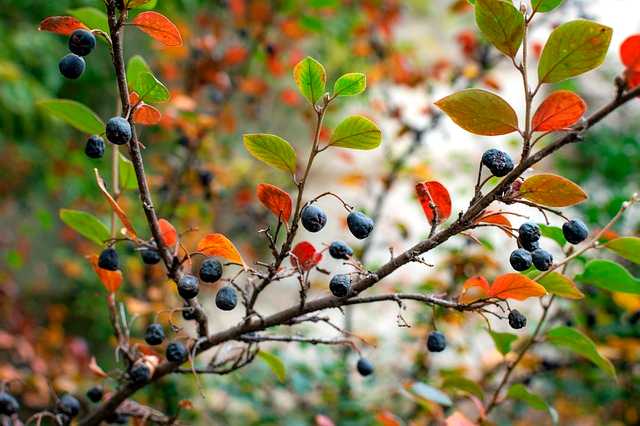
Black Chokeberry (Aronia melancarpa) is a remarkable plant that offers much more than just its striking foliage. In the fall, the leaves of Black Chokeberry turn a brilliant crimson red, creating a dramatic backdrop in gardens and natural landscapes. What sets this plant apart is its adaptability; it thrives in various soil types and can flourish in both wet and dry conditions, making it an excellent choice for diverse climates.
Beyond its aesthetic appeal, Black Chokeberry is also a powerhouse of health benefits. The berries, which start off black and shine with a glossy finish, are incredibly high in antioxidants—much more so than many other berries. They can be harvested and used to make jams, jellies, and even wines. Furthermore, these berries can be an attractive food source for birds during the winter months, encouraging local wildlife and enhancing biodiversity in your garden.
As the leaves turn red in fall, they invite changing wildlife as well, making Black Chokeberry not only a plant of visual interest but one that offers ecological support too. This unique combination of beauty, adaptability, and health benefits truly makes Black Chokeberry stand out as a wonderful addition to any landscape.
Brandywine Viburnum
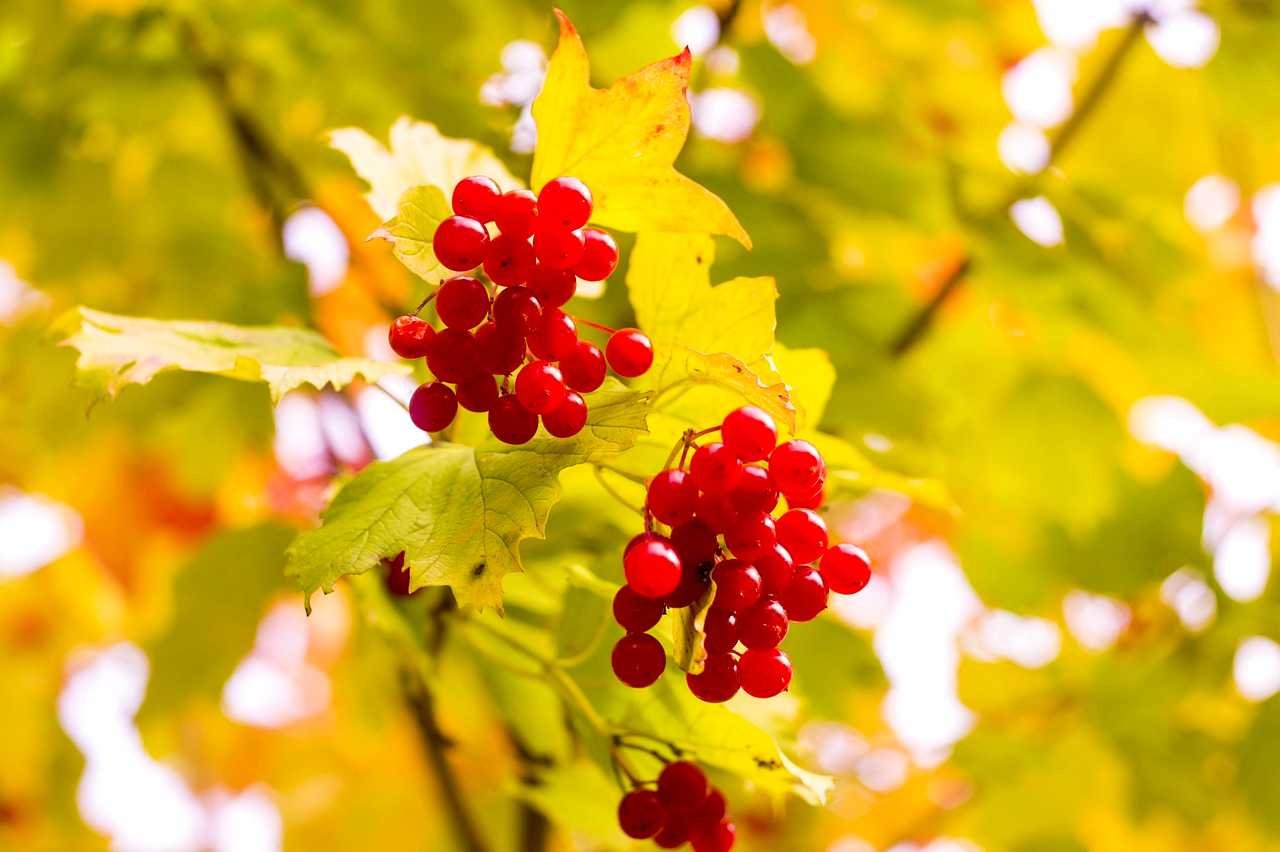
Brandywine Viburnum (Viburnum nudum ‘Brandywine’) is another stellar choice for those who appreciate the warm, fiery hues of autumn. This deciduous shrub is celebrated for its leaves that transition from a rich green in summer to a striking deep maroon, complemented by clusters of berries that morph through shades of blue and black, adding an extra dimension to the fall display.
Not only does Brandywine Viburnum provide stunning fall color, but its robust growth habit and resistance to pests and diseases render it an ideal selection for many gardeners. This shrub thrives in more acidic, well-drained soils, and its ability to adapt to a variety of light conditions—ranging from full sun to partial shade—makes it incredibly versatile for landscape design.
During the fall, the foliage is joined by attractive flower clusters that bloom in the spring, drawing pollinators like bees and butterflies. Through all four seasons, Brandywine Viburnum offers interest, with its red leaves creating a vibrant contrast against the often muted tones of fall. This multifunctional plant not only brightens your garden but also supports wildlife, and with the berries providing sustenance for birds in winter, it positions itself as a resilient staple in any landscape.
Crimson Pygmy Barberry
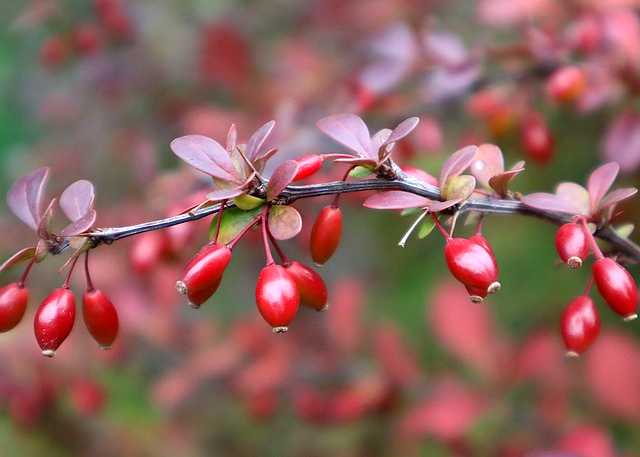
The Crimson Pygmy Barberry (Berberis thunbergii ‘Crimson Pygmy’) is a compact, deciduous shrub renowned for its phenomenal color transitions, especially in fall. As the season progresses, the foliage turns a brilliant scarlet, almost glowing against other autumn colors. This dwarf variety reaches just about 2 feet in height and width, making it a perfect selection for borders, rock gardens, or even in mass plantings.
What makes Crimson Pygmy Barberry particularly interesting is its thorny nature, which can act as a natural deterrent to pests and intruders, offering both beauty and security. The dense growth habit provides an excellent habitat for small birds and insects, fostering a thriving ecosystem within your garden.
Moreover, the crimson foliage contrasts beautifully with the yellow flowers that bloom in spring and the dark purple berries that develop in late summer, providing multi-season interest. With minimal care needs, this hardy plant thrives in average to dry soils and can withstand drought conditions once established. The combination of its stunning red fall display, hardiness, and dual-purpose function as both an ornamental and protective plant makes Crimson Pygmy Barberry a valuable addition to any fall-themed garden.
Dwarf Burning Bush Euonymus
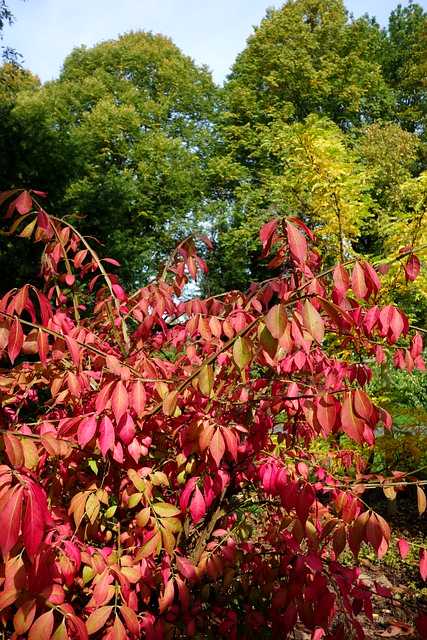
Dwarf Burning Bush (Euonymus alatus ‘Compactus’) is a landscape favorite renowned for its fiery red fall foliage that seems to ignite in vibrant color as the temperatures drop. Characterized by its compact size, this shrub only reaches about 3 to 5 feet in height, making it an ideal choice for smaller gardens or as an accent plant in larger landscapes.
Beyond its dramatic crimson transformation, Dwarf Burning Bush offers interesting architectural features throughout the year. During spring and summer, it showcases a dense, rounded shape with dark green leaves that contribute to its overall visual interest. In addition to its fall display, the plant’s unique corky wings give it a distinctive texture that stands out in any season.
Care-wise, this deciduous shrub is resilient, thriving in a variety of soil types and tolerating drought once established. Its stunning autumn display is often coupled with the production of small, inconspicuous flowers in late summer, which can develop into small berries that are not particularly palatable to humans but provide a food source for birds. As a perfect foundation plant or a low hedge, Dwarf Burning Bush captures the spirit of fall with ease while requiring minimal upkeep, making it a must-have for any gardener looking to enhance their landscape with striking autumn colors.
Highbush Blueberries
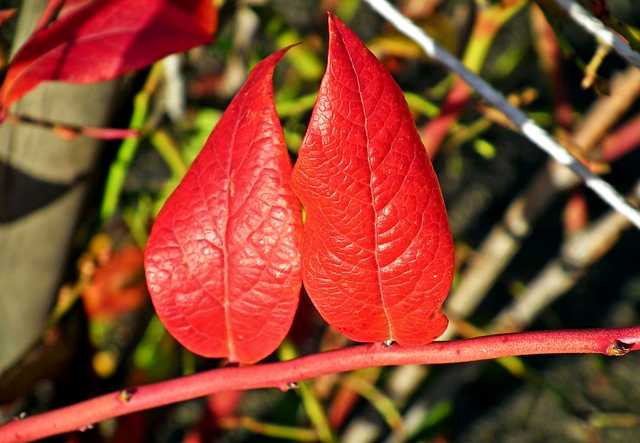
Highbush Blueberries (Vaccinium corymbosum) are well-known for their delicious fruits and their stunning transformation as fall arrives. While summertime brings an abundance of sweet, plump berries that attract wildlife and delight gardeners, it’s the fall that truly showcases this plant’s aesthetic potential. Leaves of Highbush Blueberries transition into sensational shades of red, orange, and purple, providing a rich mosaic of colors that can light up any garden.
What makes Highbush Blueberries particularly fascinating is their role in promoting biodiversity and improving soil health. As nitrogen-fixing plants, they support robust ecosystems by enriching the soil, which is beneficial for surrounding flora. Moreover, these plants thrive in acidic soils, making them ideal candidates for enhancing underutilized areas of the garden.
Not only do these plants contribute to the visual splendor of fall, but the berries they produce provide a sweet harvest, making them a favorite for home gardeners and chefs alike. The vibrant foliage and nutrient-rich fruits support both local wildlife and human enjoyment, culminating in a plant that is as fruitful as it is beautiful. For those considering plants that turn red in fall, the Highbush Blueberry stands out as a versatile option that marries aesthetics with functionality in a deliciously delightful way.
Red Chokeberry
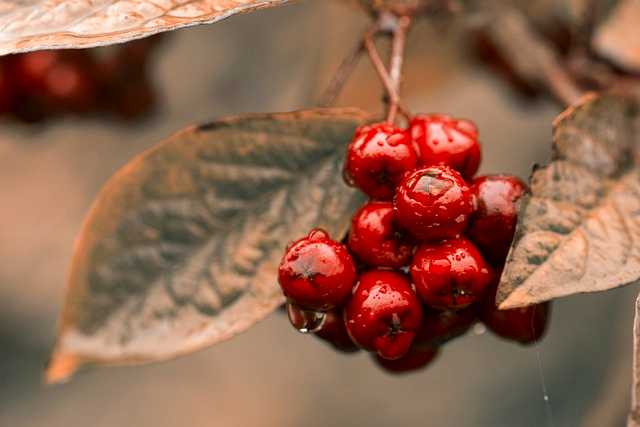
Red Chokeberry (Aronia arbutifolia) is a deciduous shrub that not only captivates with its stunning red foliage but also with its incredibly productive berries. As autumn arrives, the leaves shift from lush green to brilliant red, creating a vivid contrast against the clusters of bright red berries that persist into winter. The shrub typically grows between 5 and 10 feet, making it suitable for naturalized settings, hedges, or borders.
In addition to its visual appeal, Red Chokeberry holds significant ecological importance. The glossy, tart berries—while somewhat astringent for human palates—are a favorite food source for birds and other wildlife during the colder months when resources are scarce. The shrub also thrives in various soil conditions, from wet to moderately dry, and can tolerate both full sun and partial shade, making it a versatile addition to diverse plantings.
In spring, Red Chokeberry showcases lovely, fragrant white flowers that bloom in clusters, attracting bees and other pollinators, enhancing biodiversity in your garden early in the season. As the year progresses and the leaves turn red in fall, the striking display of colors and the plant’s ecological contributions create a compelling argument for including this versatile shrub in any landscape plan.
Smooth Sumac
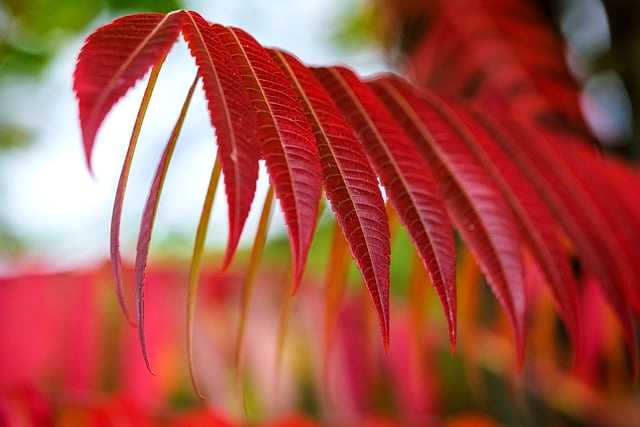
Smooth Sumac (Rhus glabra) is a splendid native shrub that provides both a visual and ecological feast in the autumn months. As the days shorten and temperatures cool, the leaves of Smooth Sumac showcase an incredible transformation, shifting from vivid green to fiery shades of red and orange that can almost resemble a blazing sunset. This shrub typically ranges from 6 to 15 feet in height, and its open, airy growth habit allows it to provide a striking display against the backdrop of a fall sky.
Besides its dazzling foliage, Smooth Sumac plays a crucial role in the ecosystem. Its dense clusters of red berries not only attract a variety of birds, including songbirds and game birds, but they are also a food source for a range of small mammals. The plant is remarkably drought-tolerant and can thrive in poor soil conditions, making it a resilient addition to any garden; it is often used for erosion control on slopes and banks due to its aggressive root system.
Furthermore, the leaves of Smooth Sumac are compound and finely serrated, creating an interesting texture throughout the growing season. In late summer, the fluffy clusters of small flowers provide nectar for pollinators like bees and butterflies, further enriching the ecological cycle. As the leaves turn red in fall, Smooth Sumac serves as both a stunning ornament and a valuable ecological contributor, embodying the essence of autumnal beauty.
Ninebark

Ninebark (Physocarpus opulifolius) is an underrated gem that brings captivating appeal to gardens in the fall. This deciduous shrub gets its name from the peeling bark which contains up to nine layers, creating a striking textured appearance that remains captivating year-round. As autumn descends, Ninebark flaunts its spectacular foliage, which transitions to vibrant shades of red, orange, and yellow, creating an eye-catching contrast against its dark bark.
Typically growing between 4 and 8 feet, Ninebark provides a sprawling habit that makes it suitable for hedging, borders, or as a specimen plant. The clusters of small white or pink flowers in late spring add to its charm and attract various pollinators, including bees and butterflies.
Ninebark is also highly valued for its hardiness and versatility. It thrives in various conditions, including poor soils and wet areas, and is tolerant of drought once established. Its ability to thrive in full sun or partial shade only adds to its desirability among gardeners. Furthermore, the shrub’s dense growth provides excellent cover for small birds and wildlife, making it a valuable contributor to the ecosystem. As the leaves take on red shades in fall, Ninebark functions as both a striking visual element and a habitat for diverse species, solidifying its role in creating an inviting garden space.
Red-Osier Dogwood
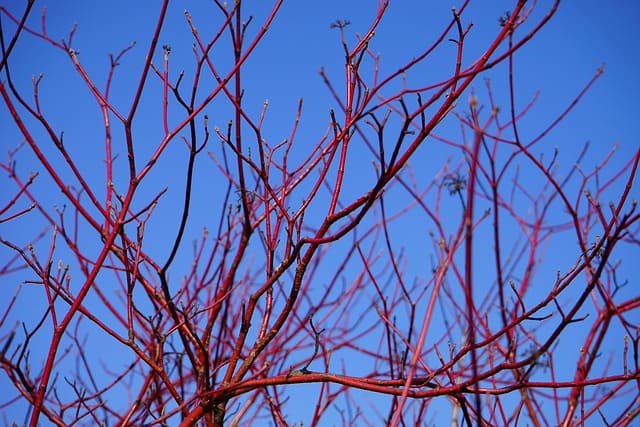
Red-Osier Dogwood (Cornus sericea) is a striking deciduous shrub known for its dramatic fall color and bright red stems. While its foliage transitions from green to a lovely burgundy red during autumn, it is the notable stems that truly stand out, offering stunning contrast especially after the leaves have fallen. This shrub typically grows between 5 and 9 feet tall, making it a great choice for use in borders, hedging, or naturalized areas.
In addition to its vibrant fall display, Red-Osier Dogwood plays a vital role in wildlife habitats. The small, white flowers that bloom in late spring yield clusters of nutritious berries, which are a favorite among birds and small mammals. Additionally, its dense growth habit provides excellent shelter for nesting birds, adding value to both the ecosystem and the garden.
This shrub thrives in moist, well-drained soils and is often found in wetland areas. It can tolerate various light conditions, from full sun to partial shade, making it a versatile option for a variety of garden settings. Moreover, Red-Osier Dogwood is excellent for controlling erosion along banks and slopes due to its robust root system. As the leaves turn red in fall, this adaptable shrub not only adds spectacular color to the landscape but also supports a diverse range of wildlife through multiple seasons.
Staghorn Sumac
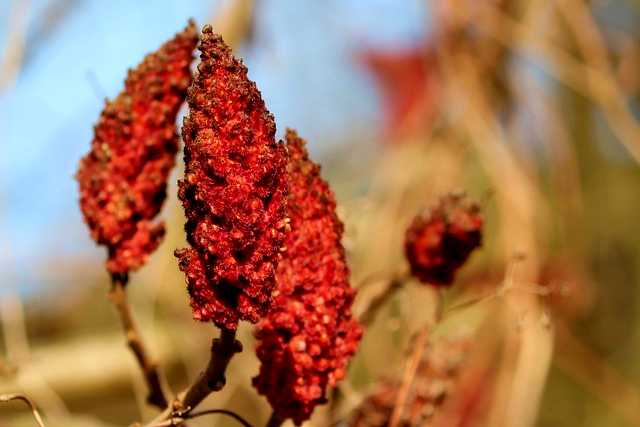
Staghorn Sumac (Rhus typhina) is a shrub that captivates gardeners with its dramatic fall foliage and unique growth habit. As the season changes, its compound leaves turn radiant shades of red and orange, illuminating the landscape. Growing between 6 to 15 feet in height, Staghorn Sumac can be used effectively as a specimen plant, in mixed borders, or as part of naturalized plantings.
One of the most distinctive features of Staghorn Sumac is its fuzzy, velvety stems, which resemble the antlers of a stag, hence the name. This plant is also interesting due to its large clusters of red drupes, which form in late summer and persist well into winter. These berries are an important food source for many birds and mammals, offering sustained nourishment as food becomes scarcer.
Staghorn Sumac is notably drought-tolerant and can thrive in poor, rocky soils, making it an excellent choice for low-maintenance landscapes. It can adapt to a variety of conditions, including full sun and partial shade. One consideration for this plant is its aggressive spreading nature; it can form colonies through root suckering, which can be either a desirable characteristic or a challenge, depending on garden design needs. As the leaves turn red in fall, Staghorn Sumac exemplifies the beauty of the season while providing wildlife value and low-maintenance appeal for gardeners.
Arrowwood Viburnum
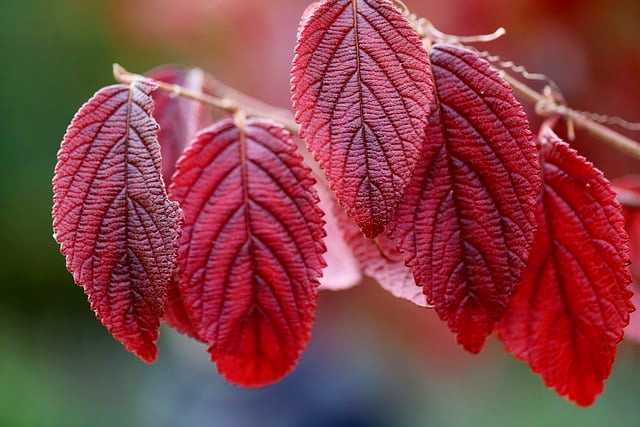
Arrowwood Viburnum (Viburnum dentatum) adds a delightful splash of color to the autumn landscape with its lustrous red foliage. In fall, the leaves of this deciduous shrub turn from a rich green to vibrant shades of red and purple, creating a beautiful backdrop in the garden. Typically growing to heights of 5 to 10 feet, Arrowwood Viburnum is commonly used for hedges or naturalized borders, providing both aesthetic appeal and utility.
The shrub is notable for its showy white flower clusters that appear in late spring, bearing sweet fragrance that attracts pollinators such as bees and butterflies. Following the blooms, the plant produces small blue-black berries. These berries not only add visual interest during the fall but also serve as an essential food source for birds, squirrels, and other wildlife throughout the autumn and winter months.
Arrowwood Viburnum thrives in various soil types, including wet soils and clay, and performs best in full sun to partial shade. Its adaptability and resistance to pests and diseases make it a reliable choice for both urban and rural gardens. As the leaves turn red in fall, Arrowwood Viburnum not only displays breathtaking autumn colors but also contributes to the vitality of local ecosystems by supporting pollinators and birds.
Witch Alder
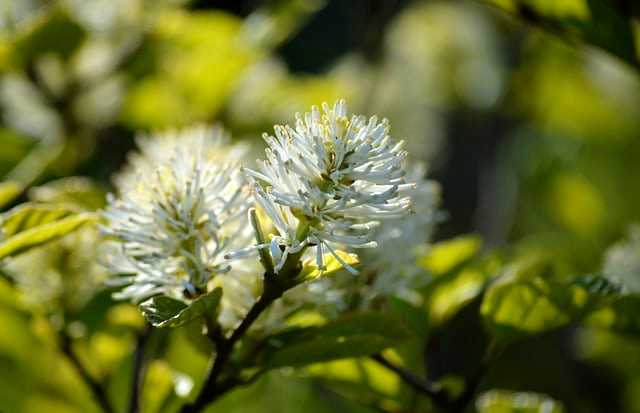
Witch Alder (Fothergilla species) is a lesser-known shrub that adds a dose of charm and versatility to the landscape during the fall season. As the summer heat wanes, its lustrous green leaves transition into brilliant shades of gold, orange, and red. This shrub typically reaches 5 to 10 feet in height and is valued for its unique leaves that resemble those of oak trees, adding an interesting textural contrast in both sunlit and shaded landscapes.
One of the standout features of Witch Alder, besides its stunning autumnal display, is its fragrant blossoms. In spring, the plant is adorned with cylindrical clusters of white flowers that emit a delightful honey-like scent, attracting bees and other pollinators. The beauty of Witch Alder extends beyond its flowers and fall colors, as it thrives in wet, acidic soils, making it an ideal candidate for rain gardens or areas prone to standing water.
An exciting aspect of Witch Alder is its adaptability. It can be planted in full sun or partial shade and can thrive in a variety of soil types while also providing habitat and food for wildlife throughout the seasons. As the leaves turn red in fall, Witch Alder stands not only as a striking visual element but also as a supportive plant in creating a healthy garden ecosystem, enhancing biodiversity, and promoting sustainability in landscape design.
Oakleaf Hydrangea
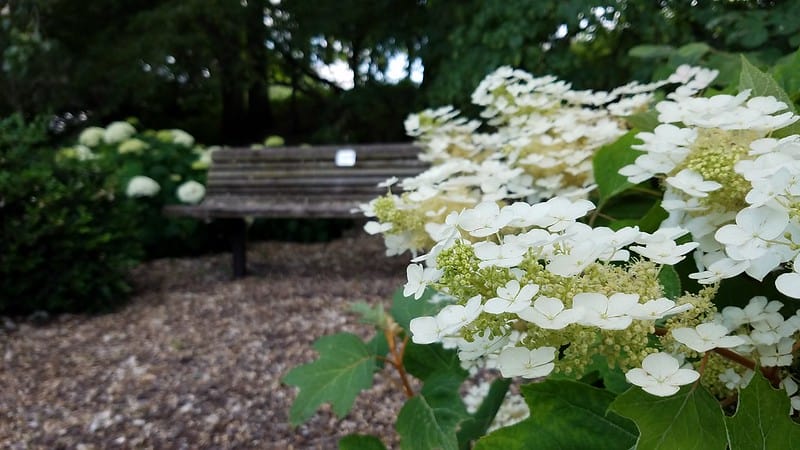
Oakleaf Hydrangea (Hydrangea quercifolia) is a remarkable deciduous shrub celebrated for its striking lobed leaves that resemble those of oak trees. As the summer fades, the leaves of Oakleaf Hydrangea transition to a stunning array of reds, maroons, and deep purples—an extravagant display that can brighten any garden setting. The shrub typically matures to a height of 4 to 6 feet, making it a versatile option for landscapes, whether as a standalone specimen or part of a mixed border.
What sets Oakleaf Hydrangea apart from its relatives is not just its magnificent fall color, but also its captivating flowers. In late spring to early summer, the shrub produces large, cone-shaped blooms that start as creamy white and gradually turn a soft pink as they mature. These flowers are not only visually appealing but also serve to attract bees, butterflies, and other pollinators, enriching the garden’s biodiversity.
Beyond its ornamental value, Oakleaf Hydrangea is known for its adaptability to a range of soil conditions, including clay and sandy soils, and it thrives in both full sun and partial shade. Additionally, it has excellent drought resistance once established. As the leaves turn red in fall, Oakleaf Hydrangea stands out as an essential plant in any garden, embodying the fullness and beauty of the autumn season while providing valuable support for local wildlife.
Serviceberry
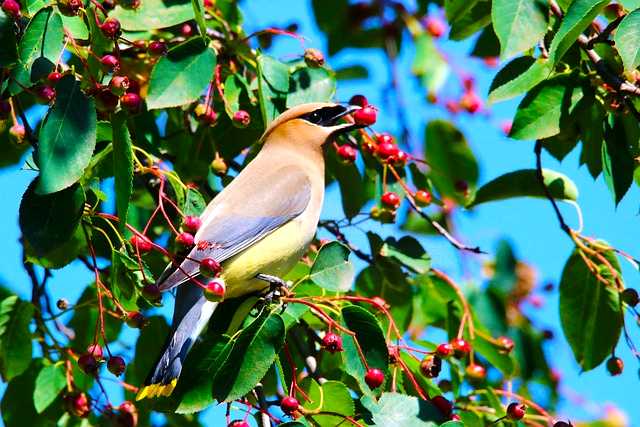
Serviceberry (Amelanchier spp.) adds a delicate beauty to the fall scene with its foliage that transforms into bright shades of orange and red. As one of the first trees to bloom in spring with its ethereal white flowers, Serviceberry offers year-round interest, culminating in its spectacular autumn display. Generally growing between 15 to 25 feet, this small tree or large shrub is perfect as a focal point or along borders in the garden.
The transformation of Serviceberry’s leaves in fall is indeed a sight to behold. The vibrant hues provide a stunning contrast against the tree’s smooth bark and the lingering berries that turn from green to a rich purple or blue-black. The berries are not only visually striking but are also a nutritious food source for birds and mammals and are often used in pies and jams, showcasing the plant’s dual purpose.
Serviceberry is adaptable to various soil types and conditions, thriving in both sun-drenched and shaded areas, which makes it an excellent addition to nearly any landscape. The tree’s adaptability allows it to flourish even in challenging urban environments, making it a favorite for landscape architects and gardeners alike. This remarkable plant is also celebrated for its ability to support wildlife, providing essential nectar for pollinators in spring and berries for birds in fall. As the leaves turn red in fall, Serviceberry stands as a beautiful reminder of nature’s changing cycles while offering vital nourishment and habitat for numerous species.





